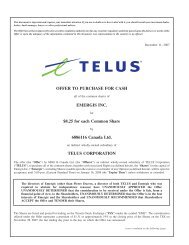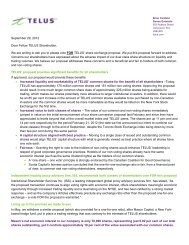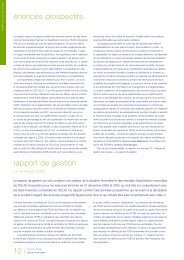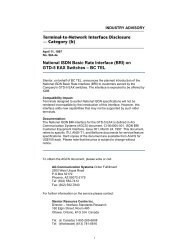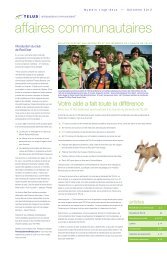Offer to purchase CLEARNET.pdf - About TELUS
Offer to purchase CLEARNET.pdf - About TELUS
Offer to purchase CLEARNET.pdf - About TELUS
You also want an ePaper? Increase the reach of your titles
YUMPU automatically turns print PDFs into web optimized ePapers that Google loves.
<strong>TELUS</strong> CORPORATION<br />
NOTES TO THE PRO FORMA CONSOLIDATED FINANCIAL STATEMENTS (Continued)<br />
June 30, 2000<br />
(unaudited)<br />
3. DIFFERENCES BETWEEN CANADIAN AND UNITED STATES GENERALLY ACCEPTED<br />
ACCOUNTING PRINCIPLES (Continued)<br />
(i) Convertible Debentures<br />
Under Canadian GAAP, financial instruments such as the 6.75% Convertible Unsecured Subordinated<br />
Debentures (the ‘‘Debentures’’) issued by Clearnet on June 19, 2000, are classified as debt or equity<br />
according <strong>to</strong> their substance rather than their legal form. Accordingly, due <strong>to</strong> the substance of the<br />
transaction the Debentures have been classified as equity and the corresponding interest expense has been<br />
charged <strong>to</strong> the deficit rather than <strong>to</strong> the Statement of Operations. Under U.S. GAAP the Debentures would<br />
be included in long-term debt and the corresponding interest expense charged <strong>to</strong> the Statement of<br />
Operations. Furthermore, under Canadian GAAP, the holder conversion option is valued separately and is<br />
treated as a distinct element from the principal of the Debentures within equity. The Debentures are<br />
discounted at an effective market rate of interest which approximates the interest rate on comparable<br />
Debentures without the holder conversion option, which results in a rate of interest that is higher than the<br />
coupon rate. The difference between the face value of the Debentures, and the present value of the<br />
Debentures discounted at the effective market rate, is the value assigned <strong>to</strong> the holder conversion option.<br />
Under U.S. GAAP there is no separate valuation of the holder conversion option, therefore, interest<br />
expense would be based on the coupon rate. Due <strong>to</strong> the difference in interest rates, interest expense under<br />
Canadian GAAP which has been charged <strong>to</strong> the deficit is $0.4 million, as compared <strong>to</strong> $0.3 million under<br />
U.S. GAAP which would be charged <strong>to</strong> the Statement of Operations under U.S. GAAP.<br />
(j) Extraordinary item<br />
Under U.S. GAAP, the loss on the redemption of certain Clearnet Communications Inc. 2005 Senior<br />
Discount Notes, which is included in interest expense for Canadian GAAP purposes, would have been<br />
treated as an extraordinary item.<br />
(k) Restatement of Prior Year Periods<br />
During the first quarter of 2000, the Company applied the provisions of the new Canadian accounting<br />
standard for income taxes retroactively. Under the new standard, which is substantially consistent with the<br />
U.S. accounting standard ‘‘Statement of Financial Accounting Standards No. 109 Income Taxes’’, the<br />
Company accounts for future income tax assets or future income tax liabilities at the tax rates that are<br />
expected <strong>to</strong> apply when the asset or liability is settled. As encouraged under the new rules, prior year<br />
financial statements have been restated. The effect of this change on the balance sheet as at June 30, 1999 is<br />
<strong>to</strong> increase intangible and other assets and reduce the deficit by $102.2 million. The change increases net<br />
loss and net loss per share for the six months ended June 30, 1999 by $1.6 million and $0.03, respectively.<br />
(l) Comprehensive Income<br />
SFAS 130, ‘‘Reporting Comprehensive Income’’, requires that a statement of comprehensive income be<br />
displayed with the same prominence as other financial statements. Comprehensive income, which<br />
incorporates net income, includes all changes in equity during a period except those resulting from<br />
investments by and distributions <strong>to</strong> owners. There is no requirement <strong>to</strong> disclose comprehensive income<br />
under Canadian GAAP.<br />
There are no material differences between Canadian and U.S. GAAP which would have an impact on the<br />
consolidated statements of comprehensive income except as outlined in the tables above.<br />
II-22



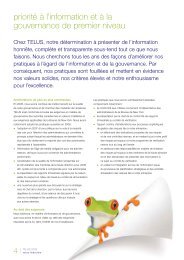
![DISK004:[98CLG6.98CLG3726]BA3726A.;28 - About TELUS](https://img.yumpu.com/16786670/1/190x245/disk00498clg698clg3726ba3726a28-about-telus.jpg?quality=85)
